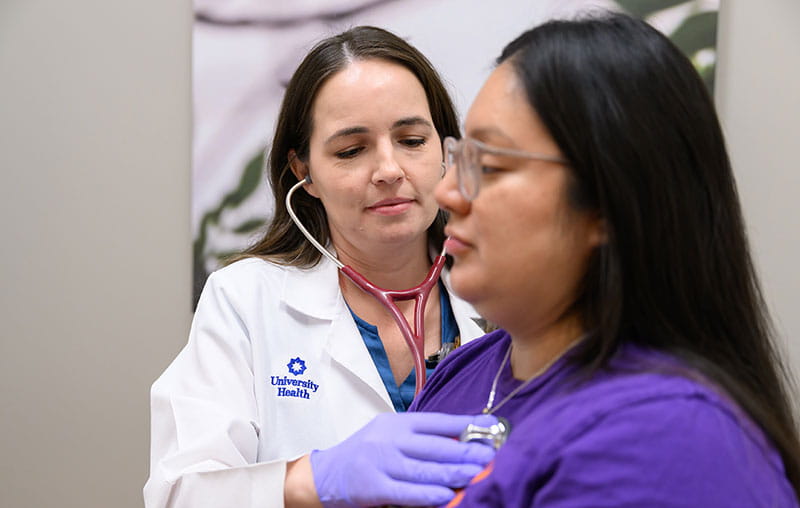Joanna Rivera’s father’s, Eulalio Rivera, health was deteriorating quickly.
His liver was cirrhotic. His condition was worsening. Joanna wanted to help.
Approximately 1,650 people die every year waiting for a liver transplant. Living-donor liver transplant programs, such as the one offered at the University Health’s Transplant Center, offer hope. Joanna Rivera donated part of her liver to her father last year.
Rivera became aware of the living liver donation procedure when she asked her father’s doctor what else could be done for him. After a three-day evaluation, she was ecstatic to discover she was a match to donate. But she still feared that her father might be too sick to have the surgery.
She recalled the surgeons at University Hospital telling her that if they discovered her father would not survive while she was on the operating table, a piece of her liver could go to someone else in need of a liver transplant. She didn’t hesitate.
“I’m going to donate,” Rivera said. “Sometimes we have to experience this for ourselves to realize how many people are in need. I want to save a life, preferably my dad, but if not, I’ll save someone else in honor of my dad.”
Rivera was able to donate to her father, and now six months after the surgery, she says she feels great and he’s getting stronger every day.
Saving lives through innovation
On average, fewer than 400 living liver donations are performed every year in the U.S., partly because only a few centers or hospitals offer this type of program. One of these, University Transplant Center, was the second-largest live liver donor program in the nation last year and one of the only programs of its kind in the state of Texas.
“We continue to see increasing numbers of people going on the liver waiting list, especially in South and Central Texas,” said Jennifer Milton, RN, who oversees operations of transplant services. “The prevalence of liver cancer and fatty liver disease are a major reason for this rise. Unfortunately, we are not seeing corresponding increases in deceased liver donations. So, as the waiting list continues to get bigger, organ donations are staying flat.”
With nearly 14,000 people on the national waiting list for a liver transplant, a donated organ often doesn’t come soon enough. But the University Transplant Center matches patients to living donors, usually someone the patient knows, but sometimes a stranger. And when a patient gets a liver from a living donor, Milton says, survival rates are higher than 90%.
How does a living liver donation work?
During a living liver donation procedure, the patient’s diseased liver is removed and a portion of the healthy donor’s liver is transplanted in its place. Within a few weeks, the remaining portion of the liver in both the donor and patient regenerates and continues to grow over three to nine months into a fully functioning liver. Before the procedure begins, surgeons determine how much of the liver both donor and patient will need for normal function after recovery.
If you want to become a donor, you must go through a medical and psychological evaluation to ensure a donation is safe for you. Living liver donation requirements include:
- 21-60 years old
- in very good health
- ability to understand the donation process
- blood type compatible
If you are not a compatible match for your intended recipient, it is possible to participate in another living liver donation option – Liver Paired Donation Exchange. In this scenario, the donor and patient aren’t a match for each other, but another patient/donor pair can “swap” donors, allowing both patients to receive living liver transplants.
Once a donor match is made: What happens next?
Once the donor understands the six- to eight-week recovery time and possible complications, surgery can be scheduled.
The risks of living-donor liver transplant are similar to typical surgical complications. Liver donors could have rare risks involved that require medical management by the transplant team until they’re resolved.
After recovery, a person who has donated a portion of their liver has a normal life. Female donors can even have further pregnancies; it is safe. The recipient must take daily medication to suppress components of the immune system to prevent organ rejection.
“I will forever be grateful to my daughter,” said Eulalio Rivera. “Thanks to her, I have another chance at life and the chance to see my grandchildren grow up.”
“The doctors at University Hospital made it happen,” Joanna Rivera added. “They said they’ve never seen someone so sick who is recovering so well. It was just amazing.”
For more information about living liver donor transplants, call 210-567-5777 or visit the University Transplant Center website.




